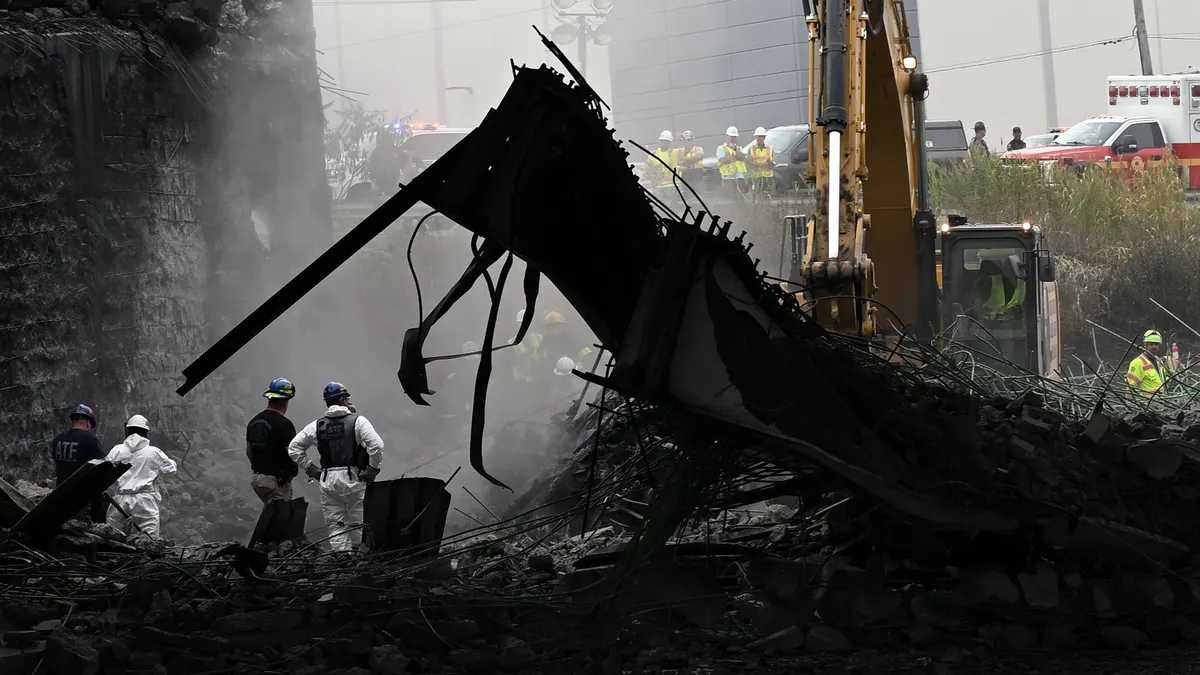UPDATE 6/20:
On Saturday, Pennsylvania Governor Josh Shapiro announced during an aerial tour with President Joe Biden that the collapsed section of I-95 would reopen within two weeks.
Philadelphia-based contractor Buckley & Co. has been tapped to build a temporary roadway and bridge to replace the I-95 span, per a press release from the governor’s office.
Sewell, New Jersey-based C. Abbonizio Contractors was hired to handle the demolition of the damaged bridge and road, and completed work in just four days.
The Federal Highway Administration announced Thursday $3 million in “quick release” Emergency Relief funds for Pennsylvania DOT to use for repairs, according to a U.S. DOT press release.
The funding will be used to maintain emergency operations and detour routes, demolish damaged structures, make emergency repairs to restore essential traffic, as well as for preliminary engineering and design for permanent restoration of the damaged section of I-95.
Buckley & Co. has begun pouring foamed glass aggregate into the gap in the roadway to build it up to the surface level of I-95, according to the governor’s office release. Pennsylvania DOT has set up a live feed so the public can watch the rebuilding process in real time.
Original story continues below.
Dive Brief:
- A tanker fire below an elevated section of Interstate 95 caused the highway to collapse in Philadelphia this weekend, killing at least one person and forcing the closure of the major East Coast artery, which officials expect to take months to repair.
- Pennsylvania Gov. Josh Shapiro said that the section on the northbound side of I-95 had completely collapsed and the southbound side is not structurally sound to carry any traffic over it. He issued a disaster declaration Monday to draw on federal funds to expedite rebuilding of the highway bridge.
- The proclamation makes $7 million of state funds immediately available for the reconstruction of the roadway and authorizes state agencies to use all available resources and personnel as necessary. The proclamation also cuts red tape, waiving bidding and contracting procedures, as well as other formalities normally prescribed by law.
Dive Insight:
Shapiro said Pennsylvania’s state agencies are working “all hands on deck” and Transportation Secretary Pete Buttigieg pledged the federal transportation department’s support.
“We will rebuild and recover,” the governor said.
Exeter, Pennsylvania-based Kuharchik Construction is helping repair cellular communications, traffic cameras, cables, fiber-optic systems and other critical network components around the collapsed I-95 bridge. The company started work Sunday afternoon, which entails searching for problems, locating what is broken, troubleshooting and making a plan for repairs, according to Kuharchik Construction CEO Robert Bresnahan.
Kuharchik Construction has three crews with 16 to 20 technicians at the site, ensuring traffic signal and CCTV systems are working, locating fiber-optic breaks and deploying variable message signs to make sure motorists know where to go, Bresnahan told Construction Dive. He said the situation snowballs with every hour that goes by, so it’s hard to estimate how long work will take.
“There’s highly technical equipment that has to be deployed to fix fiber optic cable,” Bresnahan said. “It’s a complicated puzzle, it’s a real challenge, but this is what we do and this is what the DOT relies on our expertise for.”
Sewell, New Jersey-based C. Abbonizio Contractors is also helping with the I-95 rebuild effort, the company said.
Although 7.5% of U.S. bridges are considered structurally deficient per the American Society of Civil Engineers, the I-95 span was not one of them. The I-95 bridge is supported by steel girders, which are typically susceptible to heat. Inspection reports said the bridge was in good condition, but the tanker fire could easily have produced temperatures high enough for the steel to lose strength and collapse, the Philadelphia Inquirer reported.
While not common, such collapses do happen: Fire caused 30 bridge failures in the U.S. from 1980 to 2012, or about one per year, an analysis by University of Buffalo engineers showed, and 13 of those failed bridges were made of steel.
Transport Dive reporter Colin Campbell contributed to this story.














